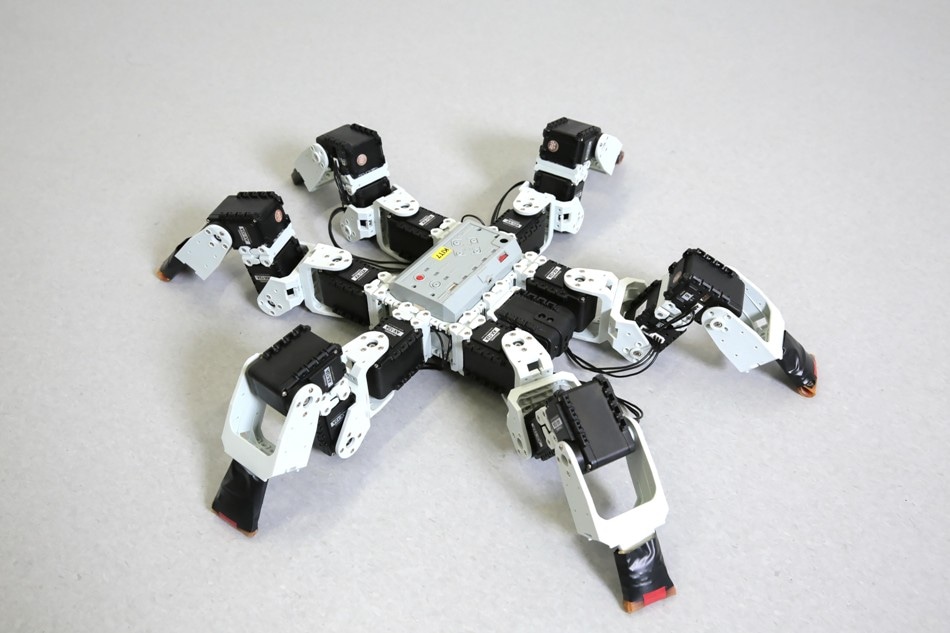Feb 20 2017
 � Alain Herzog/2017 EPFL
� Alain Herzog/2017 EPFL
A team of scientists from EPFL and UNIL have discovered a swifter and more efficient gait, which has never been witnessed in nature, for six-legged robots walking on flat ground. Generally less efficient for robots, bio-inspired gaits are used by real insects as they possess adhesive pads to walk in three dimensions. The results provides new information to biologists and new approaches for roboticists.
The legs of vertebrates make minimal contact with the ground when they run. However insects are different. These six-legged creatures run fastest using a “tripod” or three-legged gait where three of their legs are always on the ground at all times – two on one side of their body and one on the other side.
Engineers who design six-legged robots have been curious about the tripod gait for a long time. However, the question remains whether it is the fastest and most efficient means for bio-inspired robots to move on the ground?
The research team showed that there is a faster way for robots to move on flat ground, given that they do not have the adhesive pads used by insects to scale ceilings and walls.
This implies that engineers of insect-inspired robots should move away from the tripod-gait model and instead look at other possibilities including a new locomotor approach based on the “bipod” gait. The details of the research have been published in Nature Communications.
The scientists conducted tests on robots, a multitude of computer simulations, and experiments on Drosophila melanogaster – the most frequently researched insect in biology.
We wanted to determine why insects use a tripod gait and identify whether it is, indeed, the fastest way for six-legged animals and robots to walk.
Pavan Ramdya, Co-lead and Corresponding Author of the Research Paper
To explore the different combinations, the team used an evolutionary-like algorithm to improve the walking speed of a simulated insect model, which was based on Drosophila. Gradually, this algorithm analyzed a variety of potential gaits, discarding the slowest and narrowing down the fastest.
Adhesive pads
The findings shed new light on issues faced by robotics engineers and biologists alike. The scientists discovered that the common insect tripod gait did materialize when they enhanced their insect model to scale vertical surfaces using adhesion on the tips of its legs.
By comparison, ground-walking simulations without the adhesiveness of insects’ legs exposed that bipod gaits, where only two legs touch the ground at one particular time, are swifter and more efficient – even though no insects in nature actually walk this way.
Our findings support the idea that insects use a tripod gait to most effectively walk on surfaces in three dimensions, and because their legs have adhesive properties. This confirms a long-standing biological hypothesis. Ground robots should therefore break free from only using the tripod gait.
Pavan Ramdya, Co-lead and Corresponding Author of the Research Paper
Polymer boots
The scientists then constructed a six-legged robot that can use either the bipod or tripod gait. The bipod gait was again revealed to be quicker, confirming the simulation algorithms’ results.
Finally, the team studied real insects. To check whether leg adhesion might also influence the walking coordination of real flies, they coated polymer on the legs of flies to cover their adhesive pads and claws – so that it looked like the flies were using boots, and observed what happened.
Soon the flies began to use bipod-like leg coordination akin to the one revealed in the simulation.
This result shows that, unlike most robots, animals can adapt to find new ways of walking under new circumstance. There is a natural dialog between robotics and biology: Many robot designers are inspired by nature and biologists can use robots to better understand the behavior of animal species. We believe that our work represents an important contribution to the study of animal and robotic locomotion.
Robin Thandiackal, Co-lead Author of the Study
Six-Legged Robots Faster Than Nature-Inspired Gait
Researchers at EPFL and UNIL have discovered a faster and more efficient gait, never observed in nature, for six-legged robots walking on flat ground. Bio-inspired gaits -- less efficient for robots -- are used by real insects since they have adhesive pads to walk in three dimensions. The results provide novel approaches for roboticists and new information to biologists. (CREDIT - EPFL/Alain Herzog)